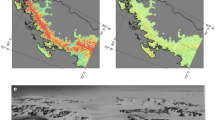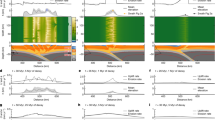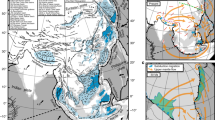Abstract
In ancient orogens, such as the Appalachian Mountains in the eastern United States, the difference between the high and low points—topographic relief—can continue to increase long after the tectonic forces that created the range have become inactive. Climatic forcing1 and mantle-induced dynamic uplift2,3 could drive formation of relief, but clear evidence is lacking in the Appalachian Mountains. Here I use a numerical simulation of dynamic topography in North America, combined with reconstructions of the sedimentation history from the Gulf of Mexico4, to show that rejuvenation of topographic relief in the Appalachian Mountains since the Palaeogene period could have been caused by mantle-induced dynamic subsidence associated with sinking of the subducted Farallon slab. Specifically, I show that patterns of continental erosion and the eastward migration of sediment deposition centres in the Gulf of Mexico closely follow the locus of predicted dynamic subsidence. Furthermore, pulses of rapid sediment deposition in the Gulf of Mexico4 and western Atlantic5 correlate with enhanced erosion in the Appalachian Mountains during the Miocene epoch, caused by dynamic tilting of the continent. The model predicts that such subsidence-induced differential erosion caused flexural-isostatic adjustments of Appalachian topography that led to the development of 400 m of relief and more than 200 m of elevation. I propose that dynamically induced continental tilting may provide a mechanism for topographic rejuvenation in ancient orogens.
This is a preview of subscription content, access via your institution
Access options
Subscribe to this journal
Receive 12 print issues and online access
$259.00 per year
only $21.58 per issue
Buy this article
- Purchase on Springer Link
- Instant access to full article PDF
Prices may be subject to local taxes which are calculated during checkout




Similar content being viewed by others
References
Boettcher, S. S. & Milliken, K. L. Mesozoic–Cenozoic unroofing of the Southern Appalachian Basin: Apatite fission track evidence from middle Pennsylvanian sandstones. J. Geol. 102, 655–663 (1994).
Miller, S. R., Sak, P. B., Kirby, E. & Bierman, P. R. Neogene rejuvenation of central Appalachian topography: Evidence for differential rock uplift from stream profiles and erosion rates. Earth Planet. Sci. Lett. 369–370, 1–12 (2013).
Gallen, S. F., Wegmann, K. W. & Bohnenstiehl, D. R. Miocene rejuvenation of topographic relief in the southern Appalachians. GSA Today 23, 4–10 (2013).
Galloway, W. E., Whiteaker, T. L. & Ganey-Curry, P. History of Cenozoic North American drainage basin evolution, sediment yield, and accumulation in the Gulf of Mexico basin. Geosphere 7, 938–973 (2011).
Poag, C. W. & Sevon, W. D. A record of Appalachian denudation in postrift Mesozoic and Cenozoic sedimentary deposits of the US middle Atlantic continental margin. Geomorphology 2, 119–157 (1989).
Molnar, P. & Lyon-Caen, H. Some simple physical aspects of the support, structure, and evolution of mountain belts. GSA Spec. 218, 179–207 (1988).
Whipple, K. X. The influence of climate on the tectonic evolution of mountain belts. Nature Geosci. 2, 97–104 (2009).
Zhang, P., Molnar, P. & Downs, W. R. Increased sedimentation rates and grain sizes 2-4 Myr ago due to the influence of climate change and erosion rates. Nature 410, 891–897 (2001).
Lithgow-Bertelloni, C. & Richards, M. A. The dynamics of Cenozoic and Mesozoic plate motions. Rev. Geophys. 36, 27–78 (1998).
Heine, C., Müller, R. D., Sterinberger, B. & Torsvik, T. H. Subsidence in intracontinental basins due to dynamic topography. Phys. Earth Planet. Inter. 171, 252–264 (2008).
Spasojevi, S., Liu, L., Gurnis, M. & Muller, R. D. The case for dynamic subsidence of the United States east coast since the Eocene. Geophys. Res. Lett. 35, L08305 (2008).
Moucha, R. et al. Dynamic topography and long-term sea-level variations: There is no such thing as a stable continental platform. Earth Planet. Sci. Lett. 271, 101–108 (2008).
Liu, L., Spasojević, S. & Gurnis, M. Reconstructing Farallon plate subduction beneath North America back to the Late Cretaceous. Science 322, 934–938 (2008).
Steinberger, B. & Calderwood, A. R. Models of large-scale viscous flow in the Earth’s mantle with constraints from mineral physics and surface observations. Geophys. J. Int. 167, 1461–1481 (2006).
Simmons, N. A., Forte, A. M. & Grand, S. P. Joint seismic, geodynamic and mineral physical constraints on three-dimensional mantle heterogeneity: Implications for the relative importance of thermal versus compositional heterogeneity. Geophys. J. Int. 177, 1284–1304 (2009).
Paulson, A., Zhong, S. & Wahr, J. Inference of mantle viscosity from GRACE and relative sea level data. Geophys. J. Int. 171, 497–508 (2007).
Steckler, M. S. & Watts, A. B. Subsidence of Atlantic-type continental margin off New York. Earth Planet. Sci. Lett. 41, 1–13 (1978).
Galloway, W. E., Whiteaker, T. L. & Ganey-Curry, P. History of Cenozoic North American drainage basin evolution, sediment yield, and accumulation in the Gulf of Mexico basin. Geosphere 7, 938–973 (2011).
Feng, J., Buffler, R. T. & Kominz, M. A. Laramide orogenic influence on late Mesozoic–Cenozoic subsidence history, western deep Gulf of Mexico basin. Geology 22, 359–362 (1994).
Peel, F. J., Travis, C. J. & Hossack, J. R. Genetic structural provinces and salt tectonics of the Cenozoic offshore US Gulf of Mexico: A preliminary analysis. AAPG Mem. 65, 153–175 (1995).
Galloway, W. E. Sedimentary Basins of the WorldCh. 15, (Elsevier, 2008).
Spasojevic, S., Liu, L. & Gurnis, M. Adjoint models of mantle convection with seismic, plate motion, and stratigraphic constraints: North America since the Late Cretaceous. Geochem. Geophys. Geosyst. 10, Q05W02 (2009).
Liu, S., Nummendal, D. & Liu, L. Migration of dynamic subsidence across the Late Cretaceous United States Western Interior Basin in response to Farallon plate subduction. Geology 39, 555–558 (2011).
Galloway, W. E., Ganey-Curry, P. E., Li, X. & Buffler, R. T. Cenozoic depositional history of the Gulf of Mexico basin. AAPG Bull. 84, 1743–1774 (2000).
Duvall, A., Kirby, E. & Burbank, D. Tectonic and lithologic controls on bedrock channel profiles and processes in coastal California. J. Geophys. Res. 109, F03002 (2004).
Willett, S. D. Orogeny and orography: The effects of erosion on the structure of mountain belts. J. Geophys. Res. 104, 28957–28981 (1999).
Reinhardt, L. J., Bishop, P., Hoey, T. B., Dempster, T. J. & Sanderson, D. C. W. Quantification of the transient response to base-level fall in a small mountain catchment: Sierra Nevada, southern Spain. J. Geophys. Res. 112, F03S05 (2007).
Hay, W. W., Shaw, C. A. & Wold, C. N. Mass-balanced paleogeographic reconstructions. Geol. Rundsch. 78, 207–242 (1989).
Karner, G. D. & Watts, A. B. Gravity anomalies and flexure of the lithosphere at mountain ranges. J. Geophys. Res. 88, 10419–10477 (1983).
Angevine, C. L., Heller, P. L. & Paola, C. Quantitative Sedimentary Basin Modeling 36–58 (Continuing Education Course Notes No. 32, AAPG, 1990).
Acknowledgements
I thank J. Bennett for helping to collect data on the GOM sedimentary strata. This paper benefits from discussions with S. Marshak, W. Guenthner, W. Galloway, P. Heller and W. Hay. The calculations are performed on the TACC supercomputer Stampede under the XSEDE allocation EAR130036.
Author information
Authors and Affiliations
Corresponding author
Ethics declarations
Competing interests
The author declares no competing financial interests.
Supplementary information
Rights and permissions
About this article
Cite this article
Liu, L. Rejuvenation of Appalachian topography caused by subsidence-induced differential erosion. Nature Geosci 7, 518–523 (2014). https://doi.org/10.1038/ngeo2187
Received:
Accepted:
Published:
Issue Date:
DOI: https://doi.org/10.1038/ngeo2187



